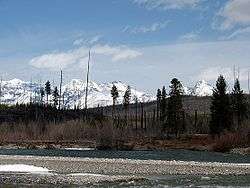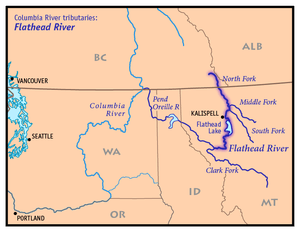North Fork Flathead River
The North Fork Flathead River (Ktunaxa: kqaskanmituk [3]) is a 153-mile (246 km)[2] river flowing through British Columbia, Canada, south into the U.S. state of Montana. It is one of the three primary forks of the Flathead River, the main inflow of Flathead Lake and a tributary of the Columbia River via the Clark Fork River and the Pend Oreille River. The river is sometimes considered the upper headwaters of the Flathead River,[4] although the North Fork is its official name in the U.S. Other naming conventions for the river include Flathead River - North Fork, North Fork of Flathead River, and North Fork of the Flathead River.[1]
| North Fork Flathead River North Fork of Flathead River, North Fork of the Flathead River | |
|---|---|
 The river at the boundary of Glacier National Park | |
 Map of the Flathead River drainage basin showing the North Fork | |
| Location | |
| Country | Canada, United States |
| Province | British Columbia |
| State | Montana |
| City | West Glacier, Montana |
| Physical characteristics | |
| Source | Clark Range |
| • location | British Columbia, Canada |
| • coordinates | 49°19′56″N 114°51′09″W[1] |
| Mouth | Flathead River |
• coordinates | 48°28′02″N 114°04′09″W[1] |
• elevation | 3,120 ft (950 m) |
| Length | 153 mi (246 km)[2] |
| Basin size | 1,560 sq mi (4,000 km2) |
| Discharge | |
| • location | USGS gage #1235550, 4.1 miles (6.6 km) from the mouth |
| • average | 2,976 cu ft/s (84.3 m3/s) |
| • minimum | 190 cu ft/s (5.4 m3/s) |
| • maximum | 69,100 cu ft/s (1,960 m3/s) |
The river originates in a valley northeast of Lake Koocanusa in the Clark Range, and flows west. It then meets the Continental Divide and turns south, winding through a broad glacial valley. The river then crosses the Canada–US border into the state of Montana, where it begins to delineate the western boundary of Glacier National Park. Roughly following the "inner" and "outer" North Fork Roads and Montana Secondary Highway 486, the river winds southwest past Kintla Lake, Bowman Lake, Quartz Lake, Logging Lake, and Lake McDonald, then turns west and south into a narrower valley before joining the Middle Fork Flathead River near the southwestern entrance of the national park, several miles northeast of Columbia Falls. Less than 6 miles (9.7 km) below this confluence, the combined river joins the South Fork Flathead River, forming the main Flathead River.[5]
Wild and Scenic River designation
_01_-_white_balanced_(10322018694).jpg)
Although the North Fork is designated as a National Wild and Scenic River (1975) in the United States, its greater length in BC (31 miles (50 km), not including headwaters forks) is not. Water in the BC section remains relatively pure as there are no permanent residents or livestock in this drainage north of the border.[6]
Dam proposal
In the 1940s the Glacier View Dam was proposed, which would have flooded much of the river's valley between Glacier View Mountain and the Canada–US border. Supported by Flathead Valley interests, the dam and reservoir were opposed by the National Park Service, as between 10,000 acres (4,000 ha) and 20,000 acres (8,100 ha) of park lands would have been flooded. The proposed dam was cancelled by 1950.[7]
See also
- Hungry Horse Reservoir
- List of rivers of Montana
References
49.1956°N 114.5109°W (source) 48.2802°N 114.0409°W (mouth)
- "North Fork Flathead River". Geographic Names Information System. United States Geological Survey. 4 April 1980. Retrieved 2009-08-29.
- Calculated by adding Canada and US numbers given in "Flathead Subbasin Plan" (PDF). Northwest Power and Conservation Council. p. 13. Archived from the original (PDF) on 16 January 2013. Retrieved 30 August 2009. and Fischer, Carol (1990). Paddling Montana. Globe Pequot. pp. 67–69. ISBN 978-1-56044-589-0.
- "FirstVoices: Nature / Environment - place names: words. Ktunaxa". Retrieved 2012-07-07.
- "Flathead River". BC Geographical Names.
- Woessner, William; Potts, Donald F.; Running, Steven W.; Kimball, John S.; DeLuca, Thomas H.; Fagre, Daniel B.; Makepeace, Seth; Hendrix, Marc S.; Johnnie, N. Moore; Lorang, Mark S.; Ellis, Bonnie K. (30 July 2004). "Flathead River Basin Hydrologic Observatory, Northern Rocky Mountains" (PDF). Consortium of Universities for the Advancement of Hydrologic Science. www.cuahsi.org. Archived from the original (PDF) on 27 June 2006. Retrieved 2009-08-29.
- "North Fork Flathead River" (PDF). American Rivers. Retrieved 2009-08-29.
- Buchholtz, C.W. (1976). "Chapter 6:Guardians of Glacier". Man in Glacier. Glacier Natural History Association. ISBN 0-916792-01-3. Retrieved 4 June 2011.